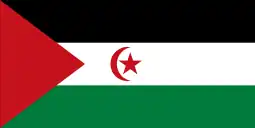Mieres
Mieres is a municipality of Asturias, northern Spain, with approximately 38,000 inhabitants.[2] The municipality of Mieres is made up of the capital, Mieres del Camino and the villages of Baiña, Figaredo, Cenera, Loredo, La Peña, La Rebollada, Santullano, Santa Rosa, Seana, Ujo, Urbies, Valdecuna, Santa Cruz, Ablaña, Turón, Gallegos, Bustiello.[3]
Mieres | |
|---|---|
 Mieres del Camín, seat of the municipality. | |
 Flag  Coat of arms | |
 Location of Mieres in Asturias. | |
 Mieres Location in Spain | |
| Coordinates: 43°15′3″N 5°46′36″W | |
| Country | |
| Autonomous community | |
| Province | Asturias |
| Comarca | Caudal |
| Capital | Mieres del Camín |
| Government | |
| • Mayor | Aníbal Vázquez (IU) |
| Area | |
| • Total | 146.03 km2 (56.38 sq mi) |
| Elevation | 386 m (1,266 ft) |
| Population (2018)[1] | |
| • Total | 38,428 |
| • Density | 260/km2 (680/sq mi) |
| Demonym | Mierenses |
| Time zone | UTC+1 (CET) |
| • Summer (DST) | UTC+2 (CEST) |
| Postal code | 33600 |
| Website | Official website |
History
Mieres is the heart of the coal mining industry in Spain.[4] The topography of Mieres is mountainous with the greatest population centers being located in the valley along the banks of the Caudal River (Río Caudal) valley in the center of Asturias.[5] Before the Spanish Industrial Restructuring Mieres was one of the industrial backbones of Asturias, and hosted 70000 inhabitants in the 1960s. Today Mieres shelters a campus of the University of Oviedo and different museums in relation with the industrial heritage.
The municipality of Mieres is served by bus routes and the regional rail lines Renfe Feve and Renfe Cercanias, connected with Oviedo, Gijón, León and Langreo.
Festivals
Mieres’ most popular and important festival St. John's Bonfire (La Foguera de San Juan)[6] occurs every June 24's eve, and is highlighted by a huge bonfire, cultural events, dancing, outdoor concerts, fireworks, al fresco dining and drinking. Another important festival is the Folixa na Primavera in April (Spring Fiesta), which includes dance and music performances from the nine European Celtic regions, food, drink and especially cider, (sidra).[7]
Politics
| Local elections | ||||||||||||
|---|---|---|---|---|---|---|---|---|---|---|---|---|
| Party/List | 1979 | 1983 | 1987[8] | 1991[8] | 1995[8] | 1999[8] | 2003[8] | 2007[8] | 2011[9] | 2015 | 2019 | |
| PCE / IU-BA | 9 | 7 | 7 | 6 | 9 | 7 | 6 | 5 | 10 | 12 | 15 | |
| FSA-PSOE | 10 | 14 | 10 | 11 | 9 | 11 | 8 | 9 | 5 | 4 | 4 | |
| CD / AP / PP | 1 | 4 | 4 | 5 | 7 | 7 | 7 | 7 | 4 | 3 | 2 | |
| Somos | 2 | 0 | ||||||||||
| FAC | 2 | 0 | 0 | |||||||||
| MCA | 1 | 0 | 0 | |||||||||
| UCD / CDS | 4 | 4 | 2 | |||||||||
| DD | 1 | |||||||||||
| Total | 25 | 25 | 25 | 25 | 25 | 25 | 21 | 21 | 21 | 21 | 21 | |
Parishes





There are fifteen parishes:
- Baíña
- Figaredo
- Gallegos
- Loredo
- Mieres del Camino
- La Peña
- La Rebollada
- Santa Cruz
- Santa Rosa
- Santullano
- Turón
- Urbiés
- Ujo
- Seana
- Valdecuna
Notable residents
- Roma Gallardo, YouTuber
- Juan Carlos Ablanedo, footballer
- José Andrés, chef
- Vital Aza, author and playwright
- María Luisa García, chef, author of the bestselling cookbook of Asturian cuisine in history[10][11]
- Innocencio of Mary Immaculate, saint
- Jenny, singer and representative of Andorra in the Eurovision Song Contest 2006
- Víctor Manuel, singer and songwriter
- Nacho Martínez, actor
- Federico Montoro, poet
- Xaviel Vilareyo, author
Twin towns
 Karviná, Czech Republic
Karviná, Czech Republic San Miguel del Padrón, Cuba
San Miguel del Padrón, Cuba Amgala, Western Sahara
Amgala, Western Sahara
References
- Municipal Register of Spain 2018. National Statistics Institute.
- "Instituto Nacional de Estadistica. (Spanish Statistical Institute)". Ine.es. Retrieved 6 October 2014.
- Archived February 28, 2009, at the Wayback Machine
- "Minería en Asturias". Html.rincondelvago.com. 17 May 2002. Retrieved 6 October 2014.
- Archived February 20, 2009, at the Wayback Machine
- Archived September 12, 2007, at the Wayback Machine
- Archived May 24, 2011, at the Wayback Machine
- Dirección General de Política Interior
- Elecciones Locales 2011
- "Muere María Luisa García, autora del mítico libro de recetas 'El arte de cocinar'". El Mundo (Spain). 2019-10-15. Archived from the original on 2019-10-19. Retrieved 2019-10-15.
- Montañés, David (2019-10-13). "Fallece María Luisa García, la centenaria maestra de la cocina casera asturiana". La Nueva España. Archived from the original on 2019-10-14. Retrieved 2019-10-15.